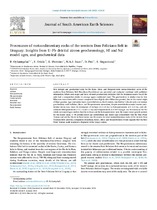| dc.contributor.author | Frei, D | |
| dc.contributor.author | Oyhantçabal, P | |
| dc.contributor.author | Oriolo, S | |
| dc.date.accessioned | 2021-04-15T09:06:58Z | |
| dc.date.available | 2021-04-15T09:06:58Z | |
| dc.date.issued | 2021 | |
| dc.identifier.citation | Frei, D. et al. (2021). Provenance of metasedimentary rocks of the western Dom Feliciano Belt in Uruguay: Insights from U–Pb detrital zircon geochronology, Hf and Nd model ages, and geochemical data. Journal of South American Earth Sciences, 108,103139 | en_US |
| dc.identifier.issn | 0895-9811 | |
| dc.identifier.uri | 10.1016/j.jsames.2020.103139 | |
| dc.identifier.uri | http://hdl.handle.net/10566/6040 | |
| dc.description.abstract | New isotopic and geochemical data for the Paleo- Meso- and Neoproterozoic metasedimentary cover of the southern Dom Feliciano Belt (Brasiliano/Pan-African) are presented and evaluated combined with published information. Whole-rock major and trace element geochemistry indicates that the dominant source for all the units had a composition similar to average upper continental crust. The geochemistry is similar even for late Ediacaran successions with a source component from slightly older Ediacaran granites, due to the crustal origin of these granites. Age constraints based on detrital zircon, fossil content, interbedded volcanic rocks and isotope geochemistry confirm Paleo-, Meso-, and Neoproterozoic successions, despite uncertainties remain in some cases. Detrital zircon data show the dominance of Archean (3.3–2.8 Ga) to Paleoproterozoic (2.2–1.9 Ga), and subordinated Mesoproterozoic (1.5–1.3 and 1.1 Ga) and Neoproterozoic (0.5–0.6 Ga) ages. Lu–Hf zircon and Sm–Nd whole-rock model ages confirm that the Archean and the Paleoproterozoic were the major crustal growth periods for the source areas. U–Pb detrital zircon age distributions and model ages demonstrate that the Nico Pérez Terrane and not the Río de la Plata Craton was the source for most metasedimentary rocks of the western Dom Feliciano Belt. Likewise, comparison of Archean, Paleo-, Meso- and Neoproterozoic events supports that the Nico Pérez Terrane could represent a fragment of the Congo Craton. | en_US |
| dc.language.iso | en | en_US |
| dc.publisher | Elsevier | en_US |
| dc.subject | Archean | en_US |
| dc.subject | Brasiliano | en_US |
| dc.subject | Crustal growth | en_US |
| dc.subject | Mesoproterozoic | en_US |
| dc.subject | Neoproterozoic | en_US |
| dc.subject | Paleoproterozoic | en_US |
| dc.title | Provenance of metasedimentary rocks of the western Dom Feliciano Belt in Uruguay: Insights from U–Pb detrital zircon geochronology, Hf and Nd model ages, and geochemical data | en_US |
| dc.type | Article | en_US |

